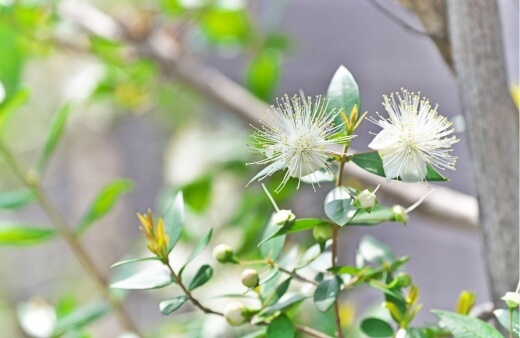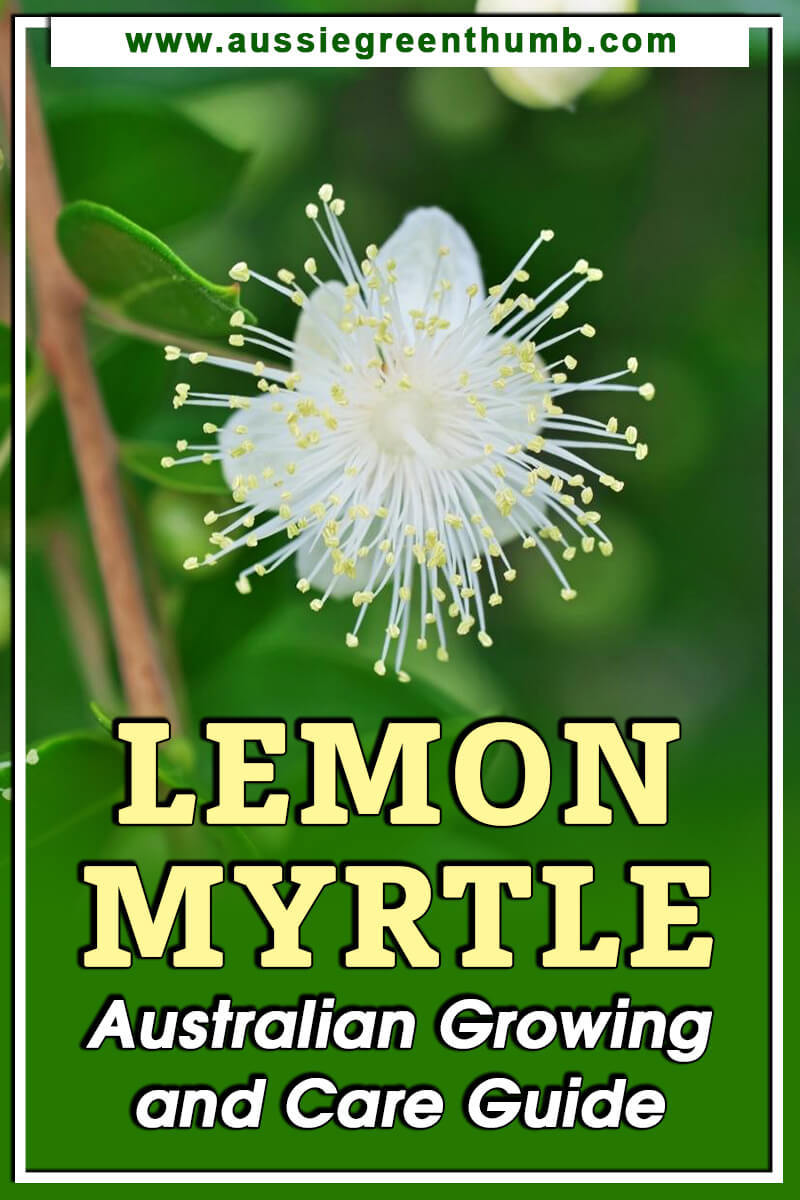Lemon myrtle is a well-known native shrub that offers a wide range of benefits for growers. Not only is lemon myrtle a great choice for landscaping, but its fragrant foliage can be used as aromatic oil or a kitchen ingredient.
Plus, this native wonder is perfectly suited for most types of gardens. Easy to establish and easy to grow, here is everything you’ll need to know to grow lemon myrtle at home.
More...
What is Lemon Myrtle?

Lemon myrtle, or Backhousia citriodora, is a sub-tropical myrtle species endemic to Queensland. This shrub has fantastic, lemon-scented, evergreen foliage, which is especially aromatic when harvested or after a good rain.
Lemon myrtle shrubs also produce masses of lightly perfumed, white fluffy flowers throughout the summer months. The flowers, which bloom in big clumps, are incredibly nectar-rich, making them incredibly beneficial to local nectar feeders.
Lemon myrtle plants are perfect for most areas in your garden, in a pot, as a hedge or even as a screening plant. It’s also a very popular kitchen ingredient.
The leaves of the lemon myrtle can be used in a variety of ways, adding an aromatic lemon flavour to meals, baked goods and teas.
Other popular names for the lemon myrtle include:
- Lemon-scented myrtle
- Lemon ironwood
- Sweet verbena tree
How to Grow Lemon Myrtle

Lemon myrtle plants will thrive provided they’re in a mostly sunny area and planted in moist, well-draining soil.
Whether in your garden or in a pot, you’ll want to ensure that your soil is enriched with plenty of organic material, which will support drainage and provide your lemon myrtle with plenty of nutrients to grow and bloom.
Lemon myrtle plants also enjoy slightly acidic soil, which makes them suitable for growing in coastal areas. Ideally, the soil P.H. level should be between 5.5 to 6.5.
Propagating Lemon Myrtle
While many gardeners choose to purchase an established plant for local, native nurseries, lemon myrtle can be propagated from a seed or cutting.

Propagating Lemon Myrtle from Seeds
- If growing from seed, you’ll want to soak the seeds overnight before sowing.
- After at least 12-hours, sow seeds into a seedling tray.
- Lightly cover the seeds with soil.
- Keep seeds in a warm and sunny spot, regularly misting to keep the soil moist.
- Germination takes around 3 to 8 weeks.
Propagating Backhousia citriodora from Cuttings
- Taking semi-hardwood cuttings is also a successful propagation method.
- Only take cuttings from a healthy, thriving myrtle plant.
- Cuttings should be around 15cm in length. Be sure to cut below the leaf node and strip the foliage from the bottom of the cutting.
- Follow our guide to taking cuttings to ensure success.
Planting Lemon Myrtle

If planting in a pot, choose a pot that is only slightly bigger than the rootball, with sufficient drainage holes. If planting into the ground, here is what you’ll need to do:
- Dig a hole that is twice the size of the root ball, with the same depth as the root ball.
- Enrich the soil with organic matter or manure before planting.
- Loosen the roots of the sapling and place them into the hole.
- Backfill with soil and gently pat down with your hands.
- Add a layer of mulch around the base of your plant, which will deter weeds and protect the roots.
Caring for Lemon Myrtle Plants
Lemon myrtle plants don’t need much attention once established. However, regular pruning and fertiliser will promote a big and vibrant bloom.
Be sure to water your lemon myrtle plant regularly when establishing, then consider cutting back to once every week. Avoid over watering during the dormant season in colder months, as this can lead to root rot.
Feed your lemon myrtle with a native fertiliser after flowering. Be sure to avoid harvesting leaves for a few days after fertilising, as it can affect the leaves and flavour. Be sure to always wash leaves after harvesting.
Tip pruning is a great idea to promote spread and bloom. Pruning can be done at any point in the year. If planning on growing your lemon myrtle as a hedge, it is recommended to prune it more often to regulate shape and size.
Here is our review on the best hedge trimmers to help you make that perfect hedge.
Harvesting Lemon Myrtle

Lemon myrtle leaves can easily be removed by hand at any point in the year. Leaves can be stored fresh or dried. If storing fresh leaves, keep them in a sealed container in your fridge to preserve freshness.
If storing dried leaves, be sure to keep them in a well-sealed glass container.
Lemon Myrtle Uses
Lemon myrtle is not only a fragrant and aesthetic plant, but the aromatic leaves are a great way to add a lemony twist to meals, baked goods and even ice cream.
Lemon myrtle can be used for teas, glazes, cakes, as well as an aromatic additive to creams or oil for aromatherapy. There is a range of lemon myrtle recipes that you can try.
Lemon myrtle has many benefits such as being known to have antifungal, antiviral and calming properties. If you’re looking to turn your lemon myrtle leaves into an oil, here is what you’ll need to do:
- Harvest a handful of fresh leaves.
- Gently crush the leaves with your hands which will start to release the oils.
- Place the crushed leaves into a jar and fill with your oil of choice (olive oil, coconut oil and argan oil are all great choices).
- Allow the leaves to marinate and infuse the oil for anywhere between 2 weeks and 2 months.
Similar to Lemon myrtle, the Grey myrtle is also packed with benefits so be sure to check out our Cinnamon myrtle how to grow and care guide to learn more about this plant.
Common Lemon Myrtle Pests, Problems & Diseases
There are a few issues you may come across with your lemon myrtle plant. These include:
- Myrtle Rust. This is a common problem, which produces purple spots with yellow spores across the leaves of your lemon myrtle. Unfortunately, there is no current treatment for myrtle rust.
However, keeping up with regular plant maintenance and pruning should avoid this issue.
- Aphids and Mites. These pesky insects are a common issue for many gardeners and many plants. They usually arise when plants are distressed. Luckily, they can be effectively treated with Neem Oil.
Looking for more myrtles to grow in your garden? Check out our comprehensive guide to growing Crepe myrtle in Australia.
Get Ready to Start Growing Lemon Myrtle today!
Are you thinking of adding some other multi-use Australian natives to the mix? Why not consider growing some finger lime trees too! You’ll be able to enjoy a wonderfully fragrant plant that you can incorporate into your cooking at any point.
Whether you’re planting an established plant or planning to propagate lemon myrtle on your own, you won’t regret adding lemon myrtle to your garden.

Published on October 31, 2021 by Gary Clarke
Last Updated on February 11, 2024




